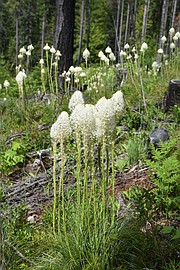Bear grass is blooming
While on the south and west face of Harvey mountain last week with my daughter Cara and grandson Ashur, we rounded a corner and were surprised by the hundreds of bear grass blooms filling the side of the mountain in front of us. The magnitude of blooms was the largest I had ever seen and one I won’t forget.
The plant was first called bear grass by members of the Lewis and Clark expedition, 19th century explorers of western America. At that time “Bear grass” was a common name for yucca (commonly called soap-weed today), which bears a superficial resemblance to bear grass. Native Americans have used bear grass roots to treat injuries. Bear grass has also been long used by Native Americans to weave baskets and braid dried leaves to adorn them on traditional buckskin dresses and jewelry.
Bear grass, a common name for xerophyllum tenax, comes from observations that bears like to eat the young, fleshy stems, although many other species use it for food or cover: from bees and beetles to rodents and elk. Though not a true grass, other common names include Indian basket grass, squaw grass, deer grass, elk grass, snap grass quip-quip and soap grass. It blooms from June to September depending on elevation.
Xerophyllum tenax has flowers with six sepals and six stamens borne in a terminal raceme. Xero is the Greek word for dry, phylum is Greek for plant, and tenax is Latin for holding fast, or tough. The plant can grow up to almost two yards in height with long and wiry, grass-like basal leaves at the base of the stalk and a cluster of small, dense white flowers at the top.
Folklore suggests bear grass blooms every five to seven years, and in some locations that is true. However, beargrass in other locations blooms every year or every 10 years. Flowering depends on site-specific conditions — particularly moisture and light.
Flowering may be influenced by spring rainfall and soil moisture but scientists are uncertain of the exact requirements for flowering. While bear grass is adapted to harsh environmental conditions, such as low moisture and nutrients levels, adequate amounts of each are needed to produce flowers.
The large, showy blooms that I saw on one south-facing ridge on Harvey Mountain consisted of 400 to 800 small creamy white flowers that opened starting at the bottom. Each flower may only be receptive to pollination for a few days, but the entire cluster may be in bloom for two weeks. Once the plant blooms it dies, but the plant may take as long as 10 years to produce flowers.
The offshoots generated give rise to the long, grass-like leaves of beargrass. However, bear grass isn’t a grass but instead a wildflower since grasses have hollow stems, small flowers with no petals and are wind pollinated.
Despite that, the name bear grass rings true. Bears use the leaves for denning material and they eat the fleshy leaf base in the spring. Mice and pocket gophers also eat the fleshy leaf base and live among the dense clumps of “grass,” hiding from raptors at the same time. In the winter, the evergreen leaves are eaten by mountain goats if other food is scarce.
For those lucky enough to live in Boundary County a bumper crop of bear grass blooms is an unforgettable sight. Time will only tell if the beargrass will bloom as profusely as this year.
According to Native American Legend, a plentiful bear grass season corresponds not only with a good huckleberry crop, but also with the “berries” sweetness.
Enjoy summer and the beauty of Boundary County.



